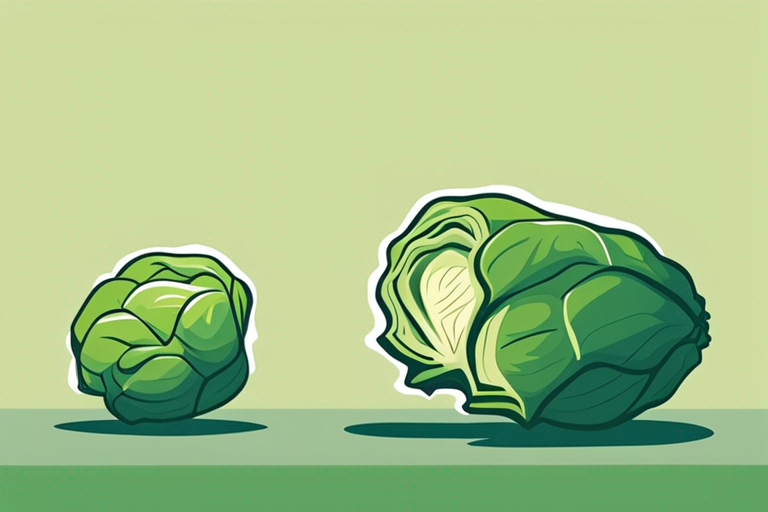
Signs that Brussel Sprouts Have Gone Bad
Signs that Brussel Sprouts Have Gone Bad
Brussel sprouts are a delicious and nutritious vegetable that can be enjoyed in a variety of dishes. However, like all fresh produce, they have a limited shelf life and can go bad if not stored properly. In this blog post, we will discuss the signs that Brussel sprouts have gone bad, as well as provide you with tips on how to properly store them to maximize their freshness and flavor. (Brussel sprouts)
Still unsure if This Food is safe?
Every situation is different. Get a personalized food safety verdict for your this food based on the date, storage, and condition — in seconds.
👉 Check Food Safety NowHow Long Do Brussel Sprouts Last?
Before we delve into the signs of spoilage, it's important to understand the general shelf life of Brussel sprouts. When stored correctly, fresh Brussel sprouts can typically last for:
- In the refrigerator: 1 to 2 weeks
- In the freezer: up to 12 months
Proper storage methods play a crucial role in extending the freshness of Brussel sprouts. Let's now explore the signs that indicate Brussel sprouts have gone bad:
Signs of Spoiled Brussel Sprouts
1. Discoloration
- Yellowing: Brussel sprouts should have vibrant green leaves. If you notice a yellowish hue on the leaves, it may indicate spoilage.
- Dark Spots: Dark spots or blemishes on the surface of the Brussel sprouts are a sign of decay.
2. Unpleasant Odor
- Sour Smell: Fresh Brussel sprouts should have a mild, earthy aroma. If they emit a sour or rotten smell, it's best to discard them.
3. Slimy Texture
- Mucous Coating: Spoiled Brussel sprouts may develop a slimy or sticky texture. This indicates bacterial growth and decomposition.
4. Mold Growth
- Fuzzy Patches: Mold growth on Brussel sprouts appears as fuzzy patches, usually in white or black colors. Do not consume Brussel sprouts with mold.
5. Softness
- Limpness: Fresh Brussel sprouts are firm to the touch. If they feel soft or mushy, it's a clear sign of deterioration.
Proper Storage Tips for Brussel Sprouts
To prolong the shelf life of Brussel sprouts and maintain their quality, follow these storage tips:
-
Refrigerate promptly: Store fresh Brussel sprouts in a perforated plastic bag in the vegetable crisper drawer of the refrigerator.
-
Avoid moisture: Excess moisture can promote spoilage. Ensure the Brussel sprouts are dry before storing them.
-
Do not wash before storing: Washing Brussel sprouts before refrigeration can accelerate decay. Rinse them just before cooking.
-
Trim and discard: Remove any yellowed or damaged outer leaves before storing Brussel sprouts.
-
Freezing: If you want to freeze Brussel sprouts, blanch them first, then place in an airtight container or freezer bag.
By following these storage guidelines, you can enjoy fresh and flavorful Brussel sprouts for an extended period.
Conclusion
In conclusion, understanding the signs that Brussel sprouts have gone bad is essential for maintaining food safety and quality. By being aware of the visual, olfactory, and textural indicators of spoilage, you can confidently assess the freshness of your Brussel sprouts before consumption. Additionally, proper storage practices play a crucial role in preserving the quality of this nutritious vegetable. Remember to refrigerate promptly, avoid excess moisture, and trim as needed to maximize the shelf life of your Brussel sprouts. With these tips in mind, you can enjoy delicious Brussel sprouts in your meals while ensuring food safety and minimizing food waste. [Learn more about Brussel sprouts](/food/brussel sprouts) and incorporate them into your culinary repertoire with confidence! (Brussel sprouts)

Still unsure if This Food is safe?
Every situation is different. Get a personalized food safety verdict for your this food based on the date, storage, and condition — in seconds.
👉 Check Food Safety NowAuthoritative Food Safety References
These agencies and university labs inform every tip and health precaution we publish.
USDA FoodKeeper – Cold Storage Guidelines
Official refrigerator, freezer, and pantry timelines maintained by the U.S. Department of Agriculture.
Visit USDA FoodKeeperFDA Produce Safety Rule & Grower Guidance
Field-to-fridge handling practices that prevent contamination of fruits, vegetables, and leafy greens.
Visit FDA Produce SafetyCDC Foodborne Illness Prevention Hub
Surveillance-backed guidance on pathogens, symptoms, and steps to reduce foodborne illness risk.
Visit CDC Food SafetyUC Davis Postharvest Technology Center
University research detailing optimal storage atmospheres for produce after harvest.
Visit UC Davis PostharvestPenn State Extension – Home Food Preservation & Safety
Peer-reviewed extension bulletins on safe canning, chilling, and reheating practices.
Visit Penn State Extension